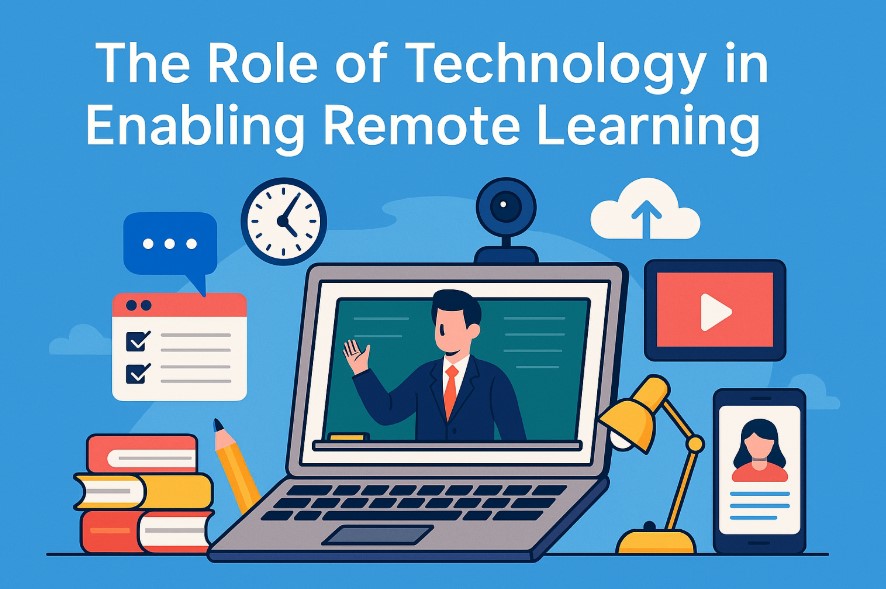Tech
The Role of Technology in Enabling Remote Learning

Remote learning has become an essential part of modern education. It allows students to study from anywhere using internet-connected devices and online platforms. This flexibility has made education more accessible for people who cannot attend physical classrooms due to distance, health, or other challenges. Technology plays the main role in making this possible by providing tools, infrastructure, and systems that support virtual teaching and learning. Understanding how technology enables remote learning helps schools, teachers, and students use these resources effectively.
Evolution of Remote Learning
Remote learning has existed for many years in different forms. Early versions included correspondence courses delivered through the mail. Later, educational radio and television programs were used to reach students at home. However, these older methods lacked interaction and real-time communication. The growth of personal computers and the internet changed this completely. With digital networks, learning could become interactive, collaborative, and available on demand. Today, advanced software, cloud systems, and mobile technology make it possible to deliver full courses online with live classes, recorded lectures, assignments, and assessments. This progress has made remote learning more reliable and widely accepted as part of mainstream education.
Core Technologies That Enable Remote Learning
Several types of technology support the delivery of remote education. These include:
- Learning Management Systems (LMS): Platforms like Moodle, Blackboard, or Google Classroom allow teachers to create, manage, and deliver online lessons. They provide tools for sharing content, grading assignments, and tracking student progress.
- Video Conferencing Tools: Applications such as Zoom, Microsoft Teams, and Google Meet allow real-time virtual classes. Teachers can present material, share screens, and interact with students as they would in a classroom.
- Digital Content and Resources: Online textbooks, educational videos, and interactive simulations help make learning materials accessible from anywhere.
- Cloud Storage: Services like Google Drive or Dropbox make it easy to store and share large amounts of data, such as lesson plans, projects, and multimedia content.
- Communication Tools: Email, chat, and discussion forums give students and teachers ways to communicate outside live classes.
- Assessment Tools: Online quizzes, tests, and automated grading tools help track student understanding and performance remotely.
These systems work together to create an online learning environment that functions as a virtual classroom.
Benefits of Technology in Remote Learning
Technology has introduced many benefits that make remote learning effective and convenient:
- Accessibility: Students can attend classes from any location with an internet connection, reducing barriers caused by distance or mobility issues.
- Flexibility: Many courses allow students to access recorded lessons and complete assignments at their own pace.
- Cost-effectiveness: Remote learning can reduce transportation, housing, and facility costs for both schools and students.
- Wider reach: Institutions can enroll students from different cities or countries without needing them to relocate.
- Resource variety: Digital platforms offer a wide range of learning resources, from videos to interactive simulations, which can improve understanding.
These benefits have encouraged schools and universities worldwide to include remote learning as part of their long-term education strategies.
Challenges of Remote Learning
Despite its advantages, remote learning also presents challenges that must be addressed:
- Technology access: Not all students have reliable internet connections or suitable devices at home.
- Engagement: Some students find it harder to stay motivated and focused without in-person interaction.
- Assessment integrity: Ensuring honesty in online exams and assignments can be difficult.
- Teacher training: Instructors need proper training to use digital tools effectively.
- Isolation: Lack of face-to-face contact can affect social development and communication skills.
Overcoming these challenges requires planning, investment, and support for both students and teachers.
The Importance of Digital Literacy
Digital literacy is the ability to use technology confidently, safely, and effectively. It has become essential for both students and teachers in remote learning. Students need skills to navigate learning platforms, submit assignments, and communicate online. Teachers must know how to design lessons, manage virtual classrooms, and solve basic technical issues. Schools can improve digital literacy by offering training sessions, support resources, and practice opportunities. When both students and teachers are digitally skilled, remote learning becomes smoother and more productive.
Role of Artificial Intelligence and Automation
Artificial intelligence (AI) has started to play a growing role in remote learning. AI systems can personalize the learning experience by adjusting content difficulty based on student performance. For example, adaptive learning platforms can give more practice problems to students who struggle and move faster for students who understand quickly. AI-powered chatbots can answer common questions, provide instant feedback, and guide students through assignments. Automation also reduces the workload for teachers by grading quizzes, organizing data, and sending reminders. These tools help make remote education more efficient and responsive to individual student needs.
Data Analytics in Education
Data analytics allows educators to track student performance in real time. Digital platforms can collect data about attendance, participation, and assessment results. Teachers can use this information to identify students who may be falling behind and offer help earlier. Analytics also show which lessons or topics are causing difficulties for most students. This helps schools improve their course designs and teaching strategies. Institutions can use data trends to plan better resource allocation and predict future needs. These insights support more informed decision-making and better learning outcomes.
Supporting Students with Special Needs
Technology has also improved access to education for students with special needs. Many remote learning platforms include features such as text-to-speech, closed captioning, adjustable font sizes, and screen readers. These tools make it easier for students with visual, hearing, or learning disabilities to participate fully in classes. Video conferencing platforms can support sign language interpreters or real-time captioning. Personalized learning plans can be created and tracked digitally. By offering accessible tools, technology ensures that remote learning includes all students and reduces educational inequalities.
Security and Privacy Considerations
One challenge of using digital tools in education is protecting data security and privacy. Remote learning platforms store personal information such as names, grades, and contact details. Schools must use secure systems and follow data protection laws to keep this information safe. Strong passwords, two-factor authentication, and encrypted communications help reduce security risks. Teachers and students should be trained on safe online behavior, including how to avoid phishing and other cyber threats. Maintaining strong security practices ensures that students can learn safely in an online environment.
Global Impact and Future Outlook
Remote learning supported by technology has made education more global. Students can join courses from other cities or even other countries. This allows them to access programs and instructors that were previously unavailable to them. It also gives schools access to a larger student base, helping them grow and share resources internationally. Looking ahead, technologies such as virtual reality (VR), augmented reality (AR), and immersive simulations will likely play a bigger role in remote education. These tools can make learning more interactive and practical. As technology advances, remote learning will become even more flexible, personalized, and engaging.
Conclusion
Technology has transformed remote learning from a basic alternative into a reliable part of modern education. It supports online classes, communication, assessments, and collaboration across distances. Tools like learning management systems, video conferencing, cloud storage, and AI platforms allow students to access lessons from anywhere and teachers to manage classes effectively. While challenges like digital access, engagement, and security remain, ongoing improvements continue to make remote education more inclusive and efficient. The term e-learning is often used when people ask which term best describes the ability of technology to facilitate remote learning, and it captures the central role that digital systems now play. As schools, universities, and training programs adopt more advanced tools, remote learning is likely to become an even more important part of education in the future.














